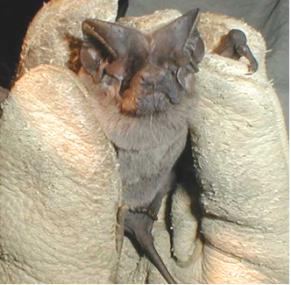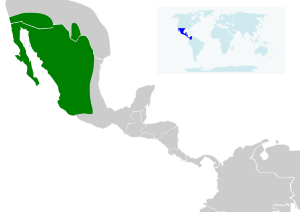Pocketed free-tailed bat facts for kids
Quick facts for kids Pocketed free-tailed bat |
|
|---|---|
 |
|
| Conservation status | |
| Scientific classification | |
| Genus: |
Nyctinomops
|
| Species: |
femorosaccus
|
 |
|
The pocketed free-tailed bat (Nyctinomops femorosaccus) is a type of bat. It belongs to the Molossidae family, also known as free-tailed bats. You can find these bats in Mexico and in parts of the United States, including Arizona, California, New Mexico, and Texas.
These bats look a lot like the Brazilian free-tailed bat. However, pocketed free-tailed bats are usually larger. Scientists consider them "un-threatened," meaning they are not currently in danger of disappearing.
Contents
What Makes Them Special
The pocketed free-tailed bat gets its name from a special skin fold. This fold stretches from its upper leg (femur) to the middle of its lower leg (tibia). This creates a small, shallow pocket on the underside of the membrane between its legs, near the knee.
These bats have some unique features:
- Their ears meet in the middle, above their head.
- A specific bone in their fourth finger is very short, less than 5 millimeters.
- The front part of their hard palate (the roof of their mouth) has a narrow cut.
- Their upper front teeth are close together and almost parallel.
Pocketed free-tailed bats also have a large, wide head with grooved lips. Their face has many stiff hairs with spoon-shaped tips. Their ears are thick and leathery, with a noticeable tragus (a small flap in the ear).
Size of a Pocketed Free-tailed Bat
These bats are about 112 millimeters (about 4.4 inches) long from head to body. Their feet are about 10 millimeters (0.4 inches) long, and their tail is around 46 millimeters (1.8 inches) long. Their ears are about 23 millimeters (0.9 inches) tall. Their forearms, which are part of their wings, are about 46 millimeters (1.8 inches) long. A pocketed free-tailed bat usually weighs between 10 to 14 grams (about 0.35 to 0.49 ounces).
Where They Live and What They Eat
Like most bats, the pocketed free-tailed bat is an insectivore. This means they eat only insects. They enjoy a variety of insects, including:
- Lepidoptera (moths and butterflies)
- Hymenoptera (ants, bees, wasps)
- Homoptera (aphids, cicadas)
- Coleoptera (beetles)
- Hemiptera (true bugs)
- Orthoptera (grasshoppers, crickets)
- Diptera (flies)
- Neuroptera (lacewings, antlions)
Scientists have studied their diet and found it changes with the seasons. For example, in June and July, they eat mostly moths and butterflies. But in September and March, their diet mainly consists of true bugs. During the dry season, they find water to drink from open sources.
Bat Roosts and Colonies
Pocketed free-tailed bats make their homes, called roosts, in different places. You can find them in caves, cracks in rocks, old mines, tunnels, and even in buildings made by people. Their colonies are usually small, with fewer than 100 bats living together.
Life Cycle and Reproduction
Pocketed free-tailed bats have a special way of reproducing called delayed fertilization. This means they mate just before the female's eggs are ready in the spring. The young bats are then born in early July.
The mother bat carries her baby for about 70 to 90 days. When the baby bats are born, they are very small, weighing only 3 to 4 grams (about 0.1 to 0.14 ounces). This is about 22% of the mother's weight! The young bats grow quickly and can fly on their own within 1 to 1.5 months after birth.
See also
 In Spanish: Nyctinomops femorosaccus para niños
In Spanish: Nyctinomops femorosaccus para niños


